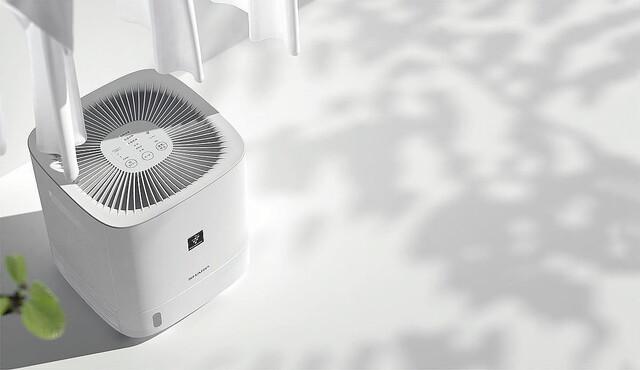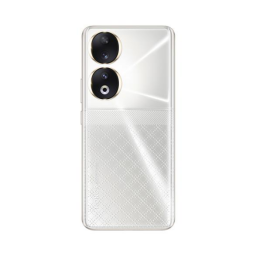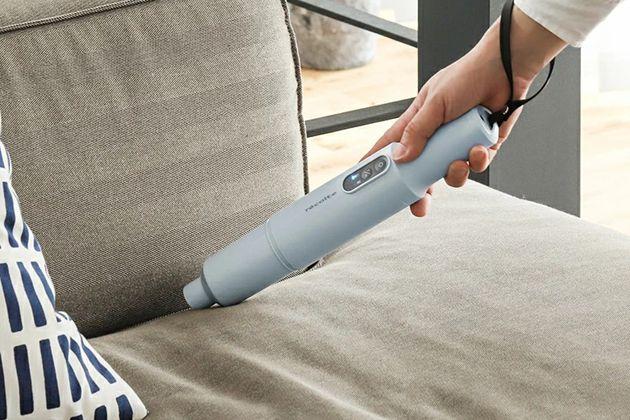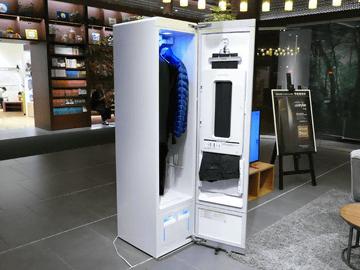Clothes drying dehumidifier "CV-P60" that is sharp and short and easy to use
Sharp will release a new product "Plasmacluster Clothes Drying Dehumidifier CV-P60" (hereinafter referred to as "CV-P60") in late April. It features a compact size of about 32 cm in height, and adopts a "360 ° all-around blowout" that sends wind from directly under the clothes. It is said that 2 kg of laundry can be dried in about 99 minutes while saving space. The price is open, and the estimated market price is around 37,000 yen.
Sharp's "Plasmacluster Clothes Drying Dehumidifier CV-P60" scheduled to be released in late April
According to a questionnaire survey conducted by Sharp, 72.2% of the respondents answered that they would like to dry their clothes in the room for the purpose of purchasing a dehumidifier. It was the top, exceeding 47% who answered "I want to reduce the humidity in the room".
The two major uses of the dehumidifier are "clothing drying" and "space dehumidification".
The frequency of room drying is 99.5% during the rainy season, 95.6% in spring, 94.2% in summer, 95.8% in autumn, and 98.1% in winter. From the above, it can be seen that many people dry their rooms in the winter as often as during the rainy season, regardless of the year.
Due to the effects of air pollution and pollen, room drying is now carried out throughout the year regardless of the weather.
On the other hand, the national average of dehumidifier ownership is 23.9%. By area, snow cover such as Hokuriku (43.1%), Tohoku (34.5%), and Hokkaido (24.6%) is followed by hot and humid areas in southern Kyushu (41.4%), Okinawa (30%), and northern Kyushu (30%). It became a high ownership rate even in the area.
Dehumidifier ownership rate by region
According to Sharp, demand for dehumidifiers is increasing due to unseasonable weather and increased awareness of cleanliness. In addition, as the number of double-income and small-group households has increased in recent years, we anticipate a slight increase in the future.
Sharp launched a clothes drying and dehumidifying machine in 2010, and subsequently released 2 models in 2015, 4 models in 2019, and 5 models in 2021. The lineup continues to expand to meet the needs of consumers, and the business scale has grown to about five times.
History of Sharp's clothes drying and dehumidifying machine
The most common dissatisfaction points with dehumidifiers are "body size" and "uneven drying". In addition, "clothes-drying racks" accounted for 46.7% of the items used for room drying.
Dehumidifier dissatisfaction and top 5 items to use for room drying
In order to eliminate these dissatisfaction points and improve usability, the first feature of the new product "CV-P60" announced recently is the space saving of low and compact size. The point is that the height is particularly suppressed. While the conventional compact model "CV-P71" has a height of 52 cn, the height of the CV-P60 is 32 cm, which is about 38% smaller. By the way, the installation area is compact with a width of 30 cm and a depth of 30 cm.
Compared to the conventional compact model "CV-P71", the height of the new product "CV-P60" is reduced by nearly 40%.
The internal structure of the main body has been redesigned to achieve miniaturization. The height has been reduced by installing the main parts such as heat exchangers, dehumidifying rotors (desiccants), PTC ceramic heaters, and turbofans, which were previously arranged vertically, horizontally.

The new product CV-P60 (left) has the main parts placed sideways.In the conventional model (right), the main parts were arranged vertically.
Also, in the past, louvers were used to blow dehumidified wind from the front to the clothes to be dried. The CV-P60 this time has been changed to a circulator-like structure that sends out wind from a 360 ° all-around blowout provided on the top surface of the main body. The wind blown sideways from the fan inside the main body is rectified vertically by hitting it against an inner frame called a casing, and the louver further controls the direction of the wind.
Mechanism of 360 ° all-around blowout
By lowering the overall height and changing the ventilation method, it can be installed directly under the laundry so that the wind can be blown efficiently. As a result, 2 kg of clothes can be dried in about 99 minutes.
The height of the main body is lowered to 32.3 cm, and it can be installed directly under the laundry.Compared to the conventional model that blows the wind diagonally from the front with the louver, there is less wind loss and the drying speed is faster.
The dehumidification method of CV-P60 is "desiccant type". While adsorbing the taken-in air with a dehumidifying rotor (desiccant) and sending out dry air, the rotor is heated with a PTC ceramic heater to evaporate the moisture. This water vapor condenses on the heat exchanger and becomes water, which collects in the tank. Since the desiccant type uses a heater, it tends to consume a large amount of power, but it has the advantage that the dehumidifying capacity does not easily decrease even in winter. Since the parts are not large, it also has the advantage of being easy to make compact.
CV-P60 dehumidifying with desiccant method
In consideration of safety, a PCT ceramic heater is used for the heater. It keeps near the target temperature without excessive temperature rise and does not become red hot. In addition, it is equipped with a function to prevent forgetting to turn off the power automatically in 12 hours, and a function to automatically stop the operation when the product falls or receives a strong impact.
Original ion generation technology "Plasmacluster 7000" is also available. In addition to the dry odor, sweat odor, and tobacco odor that adhere to laundry, it is expected to have the effect of suppressing the growth of mold bacteria.
"Plasmacluster 7000" is released into space.The applicable floor area (approximate) of Plasmacluster is about 8 tatami mats.
The drainage tank with a capacity of about 1.5L is also designed to be easy to handle. With a handle, it is easy to pull out, and with a lid, drainage is easy. The point is that there are few irregularities on the inside and it is easy to wash.
A drainage tank designed for ease of use. Capacity is about 1.5L
The air suction port is equipped with a dust block filter with an "eye" size of about 240 μm, which is the same as an air purifier. It reduces the intrusion of dust that causes performance degradation and mold.
Dust block filter
The rated dehumidification capacity (50Hz / 60Hz) is 5.4L / 5.6L per day. The drying capacity is about 2.2 people, and the standard dehumidifying area is 7 tatami mats for wooden houses and 14 tatami mats for concrete. Power consumption (50Hz / 60Hz) is 510W / 570W for clothes drying (quick drying), 480W / 540W for dehumidification (automatic), and 25W / 25W for clothes deodorization.
Operation panel on the top of the main unit.You can use three operation modes: clothes drying, dehumidification (automatic), and clothes deodorization.
The main body size is width 30 x depth 30 x height 32.3 cm, and weighs about 6.7 kg.
As a new lineup of clothes dehumidifiers and dryers in 2022, Sharp released four models of compressor type products and one model of hybrid type products on March 17th. The estimated market price is around 77,000 yen for the hybrid CV-PH140, around 72,000 yen for the compressor CV-P180, around 64,000 yen for the CV-P120, and around 42,000 yen for the CV-P71. The CV-P100, which is a compressor type and has a cold air function, costs around 55,000 yen.




![[EV's simple question ③] What is good for KWH, which represents the performance of the battery?What is the difference from AH?-WEB motor magazine](https://website-google-hk.oss-cn-hongkong.aliyuncs.com/drawing/article_results_9/2022/3/9/b2506c4670f9f2cb45ffa076613c6b7d_0.jpeg)
![[How cool is the 10,000 yen range?] 1st: The performance of the "robot vacuum cleaner with water wiping function (19800 yen)" like Rumba is ...](https://website-google-hk.oss-cn-hongkong.aliyuncs.com/drawing/article_results_9/2022/3/25/5251bb14105c2bfd254c68a1386b7047_0.jpeg)

